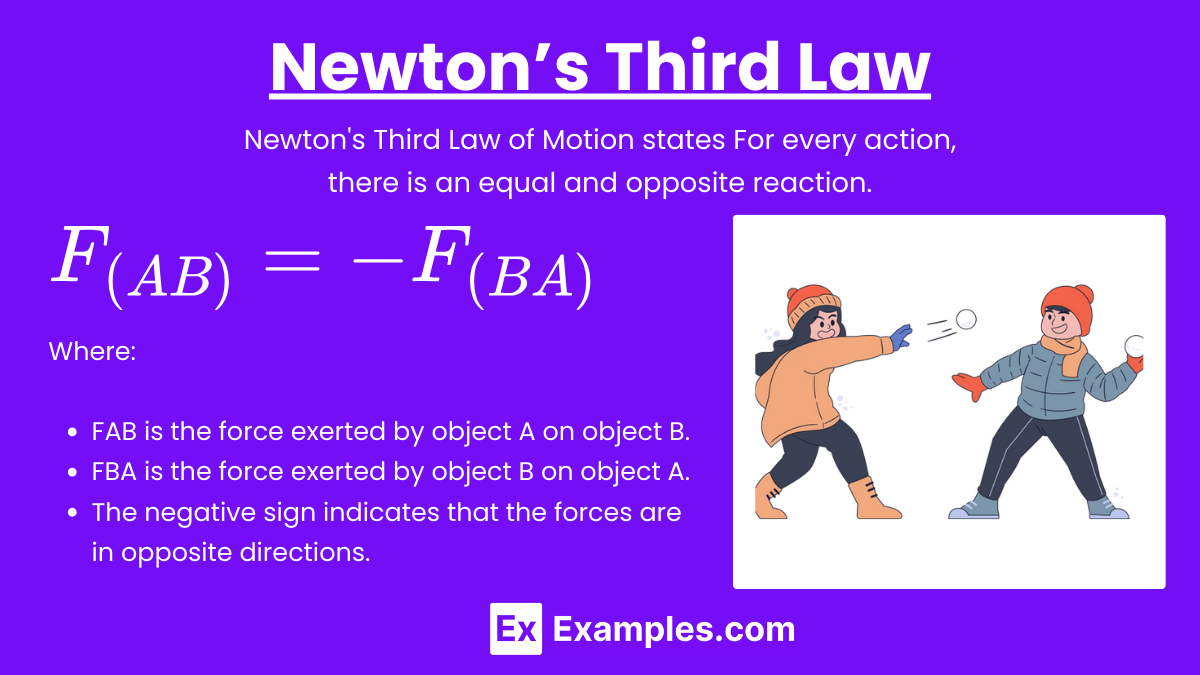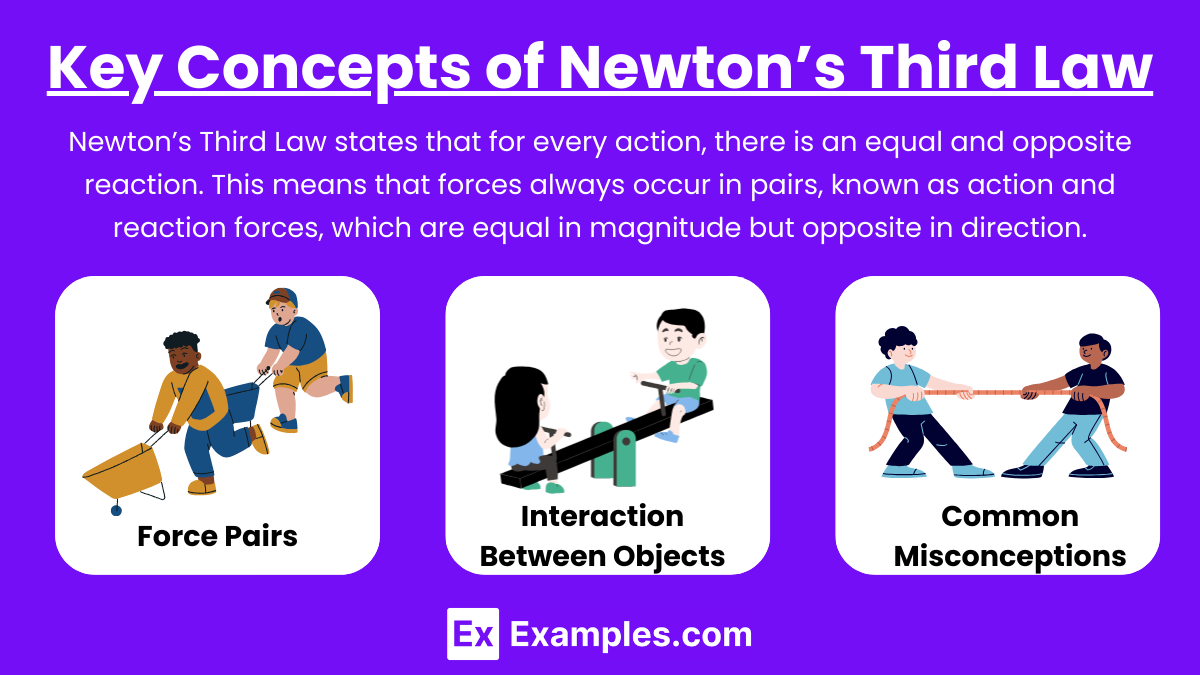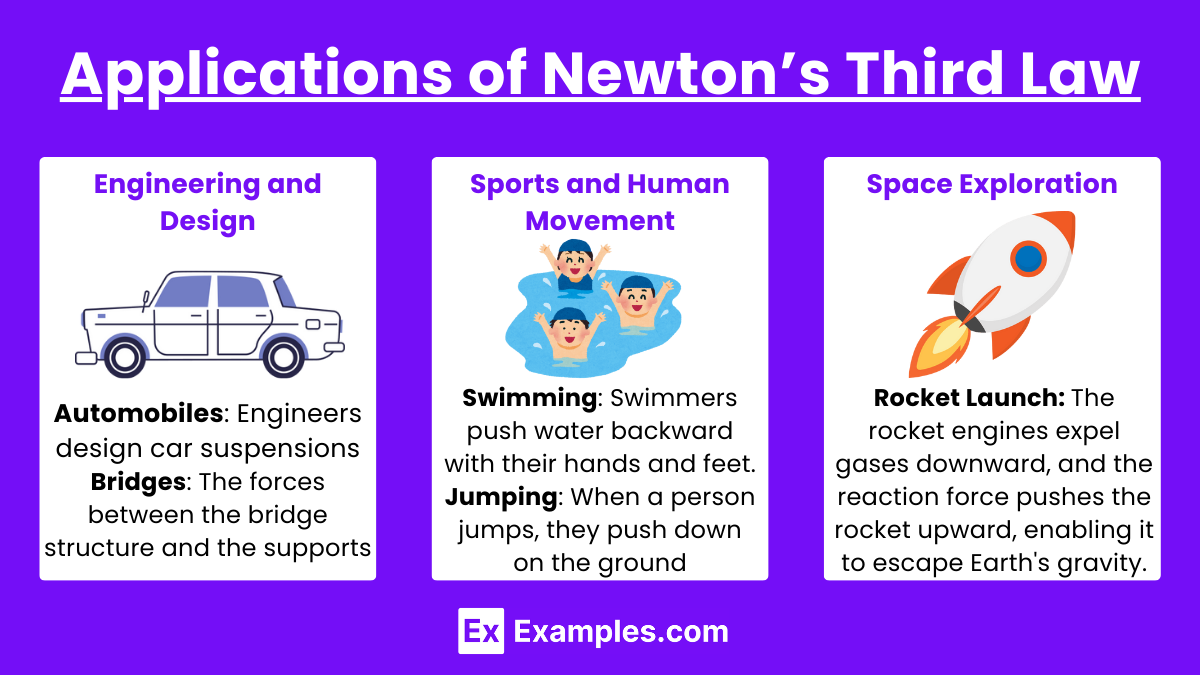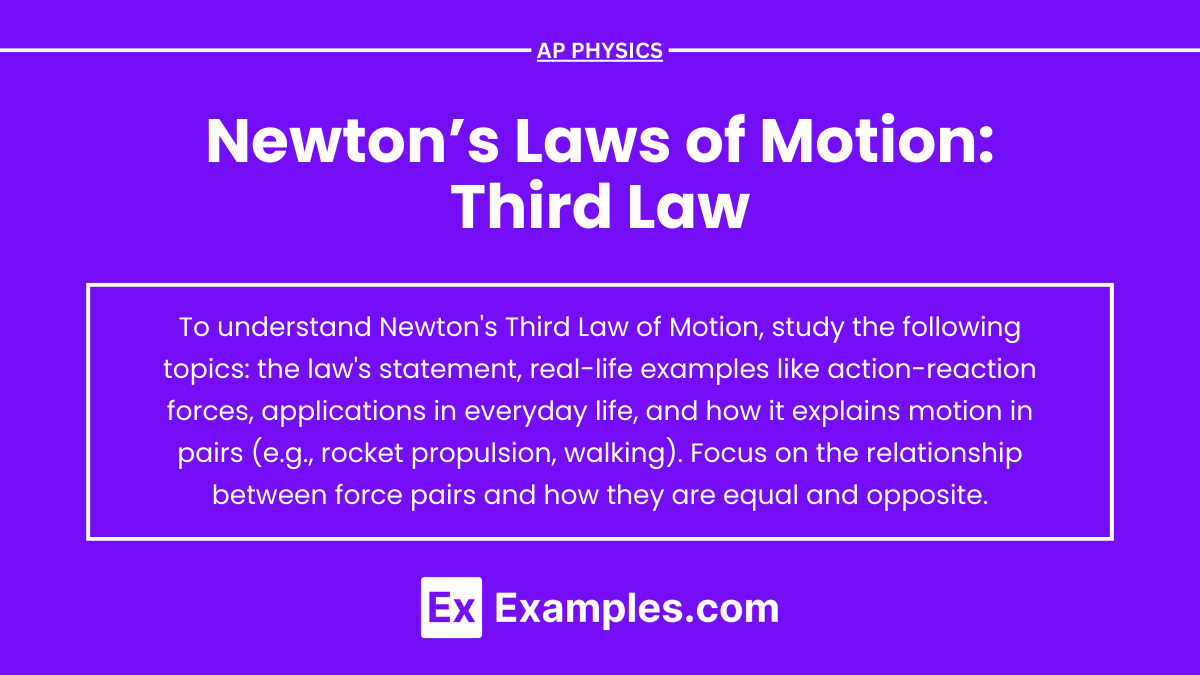Newton’s Third Law of Motion is a fundamental principle in physics that explains the interactions between forces. It states that for every action, there is an equal and opposite reaction, meaning that forces always occur in pairs. Understanding this law is crucial for solving problems related to dynamics, making it an essential concept in AP Physics. Whether analyzing the motion of everyday objects or studying complex systems, mastering Newton’s Third Law is key to excelling in the subject and achieving high scores on the exam.
Learning Objectives
When studying Newton’s Third Law of Motion for the AP Physics exam, you should focus on understanding the concept of action-reaction force pairs, recognizing how these forces act on different objects, and applying this law to various scenarios such as collisions, propulsion, and equilibrium situations. Additionally, practice solving problems that require identifying and analyzing force pairs, using free-body diagrams, and connecting this law to conservation of momentum. Mastery of these concepts is crucial for solving both conceptual and quantitative questions on the exam.
Newton’s Third Law

Newton’s Third Law of Motion states: For every action, there is an equal and opposite reaction.
This means that if an object A exerts a force on object B, object B will exert a force of equal magnitude but in the opposite direction on object A. These forces are always equal in size and opposite in direction, and they act on two different objects.
Mathematical Expression
If object A exerts a force FAB on object B, then object B exerts a force FBA on object A. Mathematically, this can be written as:
![]()
Where:
- FAB is the force exerted by object A on object B.
- FBA is the force exerted by object B on object A.
- The negative sign indicates that the forces are in opposite directions.
Key Concepts of Newton’s Third Law

1. Force Pairs
- Action and Reaction Forces: According to Newton’s Third Law, forces come in pairs known as action and reaction forces. These forces are equal in magnitude but opposite in direction.
- Simultaneous Occurrence: The action and reaction forces occur simultaneously. When object A exerts a force on object B, object B instantaneously exerts a force of equal magnitude in the opposite direction on object A.
2. Interaction Between Objects
- Mutual Interaction: The law emphasizes that the forces arise from the interaction between two objects. If there is no interaction, there are no forces.
- External vs. Internal Forces: Newton’s Third Law applies to external forces, which are forces acting between two different objects. Internal forces, like those between atoms within an object, do not affect the overall motion of the object.
3. Common Misconceptions
- Action-Reaction Pair Misunderstanding: A common misconception is that the action and reaction forces cancel each other out. However, this is not the case because they act on different objects. Therefore, they do not cancel out but instead result in a change in motion.
- Equal and Opposite Forces: It’s important to note that while the forces are equal and opposite, the effects of these forces might not be the same. The acceleration of each object depends on its mass (as per Newton’s Second Law, F=ma).
Applications of Newton’s Third Law

1. Engineering and Design
Understanding Newton’s Third Law is crucial in engineering, especially in designing vehicles, structures, and machines. For instance:
- Automobiles: Engineers design car suspensions to manage the forces between the tires and the road.
- Bridges: The forces between the bridge structure and the supports are analyzed to ensure stability and safety.
2. Sports and Human Movement
Athletes often exploit Newton’s Third Law to enhance their performance:
- Swimming: Swimmers push water backward with their hands and feet (action), and the water pushes them forward (reaction).
- Jumping: When a person jumps, they push down on the ground (action), and the ground pushes them upward (reaction).
3. Space Exploration
In space, where there is no atmosphere to push against, rockets rely entirely on Newton’s Third Law for propulsion:
- Rocket Launch: The rocket engines expel gases downward, and the reaction force pushes the rocket upward, enabling it to escape Earth’s gravity.
Problem-Solving Strategies
- Identify the Interaction Pair : When solving problems related to Newton’s Third Law, start by identifying the two objects involved and the forces they exert on each other.
- Apply the Law of Action-Reaction : Ensure that for every force you identify, there is a corresponding force of equal magnitude and opposite direction acting on the other object.
- Use Free-Body Diagrams : Drawing free-body diagrams can help visualize the forces acting on each object. This is particularly useful in complex problems where multiple forces are involved.
- Consider the System as a Whole : In some cases, analyzing the system as a whole can simplify the problem. The internal forces within a system (like action-reaction pairs) cancel out, making it easier to focus on external forces.
Examples
Example 1: Rocket Propulsion
When a rocket launches, its engines expel gases downward at high speed. According to Newton’s Third Law, these gases exert an equal and opposite force on the rocket, propelling it upward. This is why rockets can lift off from Earth and continue moving in space, where there’s no air to push against.
Example 2: Swimming
When a swimmer pushes against the water with their hands and feet, the water pushes back with an equal force. This force propels the swimmer forward. The harder the swimmer pushes against the water, the faster they move, illustrating Newton’s Third Law in action.
Example 3: Walking
When you walk, your foot pushes backward against the ground. In response, the ground pushes your foot forward with an equal and opposite force, allowing you to move ahead. This simple act of walking is a direct application of Newton’s Third Law.
Example 4: Bird Flight
Birds fly by pushing air downward with their wings. According to Newton’s Third Law, the air pushes back up with an equal and opposite force, lifting the bird into the sky. The strength and angle of the wing movement determine the bird’s speed and direction.
Example 5: Cannon Recoil
When a cannon fires a cannonball, the explosive force pushes the cannonball forward out of the barrel. Simultaneously, the cannon is pushed backward with an equal and opposite force, causing it to recoil. This recoil is a classic demonstration of Newton’s Third Law in a military context.
Multiple Choice Questions
Question 1
When a bird flies by pushing the air downwards with its wings, what is the reaction force according to Newton’s Third Law?
A) The bird moves upward.
B) The air pushes the bird upwards.
C) The wings create a vacuum.
D) The bird’s weight decreases.
Answer: B) The air pushes the bird upwards.
Explanation: According to Newton’s Third Law of Motion, for every action, there is an equal and opposite reaction. When the bird pushes the air downward with its wings (action), the air exerts an equal and opposite force upward on the bird (reaction). This upward force allows the bird to lift off and fly.
Question 2
A person is standing on a skateboard and throws a heavy ball forward. What happens to the person and why?
A) The person moves forward due to the ball’s motion.
B) The person remains stationary because the skateboard cancels the motion.
C) The person moves backward because the ball pushes them in the opposite direction.
D) The person falls off the skateboard due to loss of balance.
Answer: C) The person moves backward because the ball pushes them in the opposite direction.
Explanation: Newton’s Third Law states that every action has an equal and opposite reaction. When the person throws the ball forward (action), the ball exerts an equal and opposite force on the person, pushing them backward (reaction). Since the person is on a skateboard, they can move backward easily due to the low friction.
Question 3
Two ice skaters, one much heavier than the other, push off from each other. What will happen according to Newton’s Third Law?
A) The heavier skater moves faster than the lighter skater.
B) The lighter skater moves faster than the heavier skater.
C) Both skaters move at the same speed in opposite directions.
D) Both skaters remain stationary.
Answer: B) The lighter skater moves faster than the heavier skater.
Explanation: According to Newton’s Third Law, the force exerted by each skater on the other is equal in magnitude and opposite in direction. However, since force = mass × acceleration (F = ma), and the skaters exert equal forces on each other, the skater with less mass (the lighter skater) will experience a greater acceleration and thus move faster. The heavier skater, with more mass, will move more slowly.


